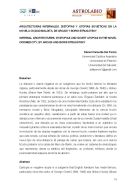Please use this identifier to cite or link to this item:
https://repositorio.uca.edu.ar/handle/123456789/8520| Título: | Arquitecturas infernales : distopías y utopías soviéticas en la novela Ciudad Maldita, de Arcadi y Boris Strugatsky Infernal architectures : dystopias and soviet utopias in the novel Doomed City, by Arcadi and Boris Strugatsky |
Autor: | Del Percio, Daniel | Palabras clave: | LITERATURA; DISTOPIA; CIENCIA FICCION; Strugatsky, Arkady, 1925-1991; Strugatsky, Boris, 1933-2012; Ciudad Maldita; NOVELA; LITERATURA SOVIETICA; LITERATURA RUSA; UTOPIA | Fecha de publicación: | 2018 | Editorial: | Universidad Nacional de Córdoba. Centro de Investigaciones y Estudios sobre Cultura y Sociedad Consejo Nacional de Investigaciones Científicas y Técnicas |
Cita: | Del Percio, Daniel. Arquitecturas infernales : distopías y utopías soviéticas en la novela Ciudad Maldita, de Arcadi y Boris Strugatsky [en línea]. Astrolabio, 20, 2018. Disponible en: https://repositorio.uca.edu.ar/handle/123456789/8520 | Resumen: | Resumen: La distopía o utopía negativa es un subgénero que ha hecho famoso la literatura inglesa, particularmente desde las obras de George Orwell (1984, de 1948) y Aldous Huxley (Brave New World, de 1932). Sin embargo, suele pasarse por alto que la primera antiutopía moderna pertenece a un autor ruso, Evgueni Zamiátin: la novela Nosotros (My), de 1922, producto de una modernidad tardía. Esta obra estableció los paradigmas que caracterizarían de ahí en más formalmente a la distopía. En 1968, los hermanos Arcadi y Boris Strugatsky, principales referentes de la ciencia ficción soviética en aquellos años, reelaboraron a partir de estas bases una ciudad ya no distópica sino infernal y oscuramente irracional, eje de su novela Ciudad maldita (Grab obrechonni), una distopía ya en clave posmoderna, llevándola a un auténtico (e irresuelto) planteo sobre la naturaleza del mal. A partir de un marco teórico que vincula la evolución de las utopías negativas con la ciencia ficción, nuestra hipótesis implica que esta novela, curiosa síntesis de ciencia, política, esoterismo y literatura, define un nuevo tipo de obra distópica. El paisaje de ruinas que implica, tan caro a la ciencia ficción posterior a la caída del Muro de Berlín, se vuelve un sistema de sinécdoques que representa, desde la estética del fragmento, un profundo nihilismo donde la posmodernidad adquiere la forma de abismo. Abstract: Dystopia or negative utopia is a subgenre that English literature has made famous, particularly since the works of George Orwell (1984, 1948) and Aldous Huxley (Brave New World, 1932). However, it is often overlooked that the first modern anti-utopia belongs to a Russian author, Evgueni Zamiátin: the novel We (My, 1922), a late modernity product. This work established the paradigms that would characterize henceforth dystopia. In 1968, the brothers Arcadi and Boris Strugatsky, leading figures of Soviet science fiction in those years, will rework from these bases a city no longer dystopian but infernal and obscurely irrational, axis of his novel Doomed City (Grab obrechonni), a Dystopia already in postmodern key, taking it to an authentic (and unresolved) statement about the nature of evil. From a theoretical framework that links the evolution of negative utopias with science fiction, our hypothesis implies that this novel, a curious synthesis of science, politics, esotericism and literature, defines a new type of dystopian work. The landscape of ruins that it implies, so valued to science fiction after the fall of the Berlin Wall, becomes a system of synecdoches that represents, from the aesthetics of the fragment, a deep nihilism where postmodernity takes the form of an abyss. |
URI: | https://repositorio.uca.edu.ar/handle/123456789/8520 | ISSN: | 1668-7515 | Disciplina: | LITERATURA | Derechos: | Acceso Abierto | Fuente: | Astrolabio, 20, 2018 |
| Appears in Collections: | Artículos |
Files in This Item:
| File | Description | Size | Format | |
|---|---|---|---|---|
| arquitecturas-infernales-distopias-utopias.pdf | 516,6 kB | Adobe PDF |  View/Open |
Page view(s)
539
checked on Apr 27, 2024
Download(s)
319
checked on Apr 27, 2024
Google ScholarTM
Check
This item is licensed under a Creative Commons License

